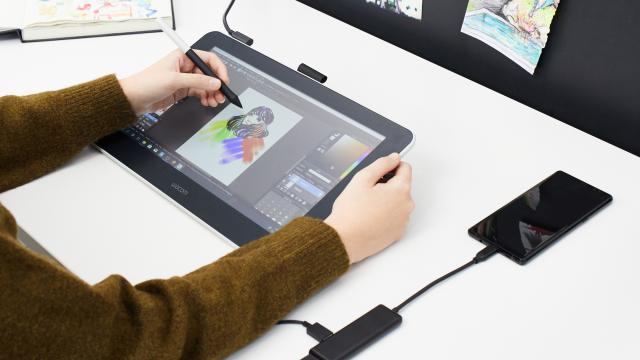It took a couple of iterations to get it right, but the Apple Pencil 2 turned the iPad into an excellent creative tool. But now Android users can hopefully get a similar artistic experience from their mobile devices with Wacom’s new One tablet—the first from the company to support connectivity to mobile devices like smartphones and tablets.
Once the de facto pen-on-screen experience for digital artists, in recent years Wacom has started facing more serious competition from companies like Apple whose tablet devices have matured into something more than just oversized smartphones for consuming books and movies. As a result, at CES 2019 Wacom introduced the Cintiq 16 which, at $US650 ($937), was the company’s most affordable pen-driven LCD tablet. Despite being very task-focused—by comparison, the iPad can almost everything your laptop can—we found the Cintiq 16 to be a better option for creative types looking for the best pen-on-screen experience.
As 2020 gets underway, however, the iPad’s capabilities as a creative tool have improved dramatically over the past year, with Adobe releasing more and more apps for the device, including a (questionably useful) version of Photoshop. To continue to remain competitive with students and artists who don’t have thousands of dollars to invest in an elaborate workstation, Wacom is now introducing the Wacom One: a 13-inch tablet with the same 1,920 by 1,080 LCD HD display as last year’s Cintiq 16, but with a smaller footprint and a smaller price tag. The Wacom One will be available this month in Australia for $599.
It’s Wacom’s cheapest LCD tablet to date, and if you’re ok with the display’s limited colour capabilities (it’s only capable of showing 72 per cent of the NTSC colour gamut so it’s not a screen you’d want to rely on for colour-critical image or illustration proofing) it introduces a feature that hasn’t been seen on Wacom’s tablets before: support for mobile devices running Android.
With the proper chain of dongles connecting the Wacom One and your Android tablet or smartphone (plus power connections for both) and a mobile device that supports an external display, users can, at least in theory, get a taste of the Apple Pencil experience without having to buy into the iOS hardware ecosystem. Adobe’s higher-end creative apps have typically premiered on Apple’s devices first, but the company has been promising and delivering Android versions shortly after.
Since touchscreen devices like smartphones first debuted there have been styluses available that mimic the pen on paper experience, but they often suffer from lag, and a writing or drawing experience that pales in comparison to an actual pen on paper. The Apple Pencil changed all that for the iPad, and the Wacom One promises to do the same for Android hardware. But, as with everything else Wacom makes, the One tablet will also work with Mac OS and Windows computers, so it’s not a mobile-only solution. For the first time the Wacom One will also work with digital pens and styluses from third-party companies like Lamy, Samsung, and Staedtler, so users don’t necessarily have to stick to the Wacom One’s included stylus if they’re not a fan of its contoured design.
We’ll be checking out the Wacom One in the coming weeks to see how it compares to the iPad Pro with an Apple Pencil 2. Based on the price tag alone of Apple’s high-end creative tools the Wacom One makes a compelling case for itself for aspiring artists, and we’re very curious to see if the excellent Wacom experience is in any way compromised when used with Android hardware.
